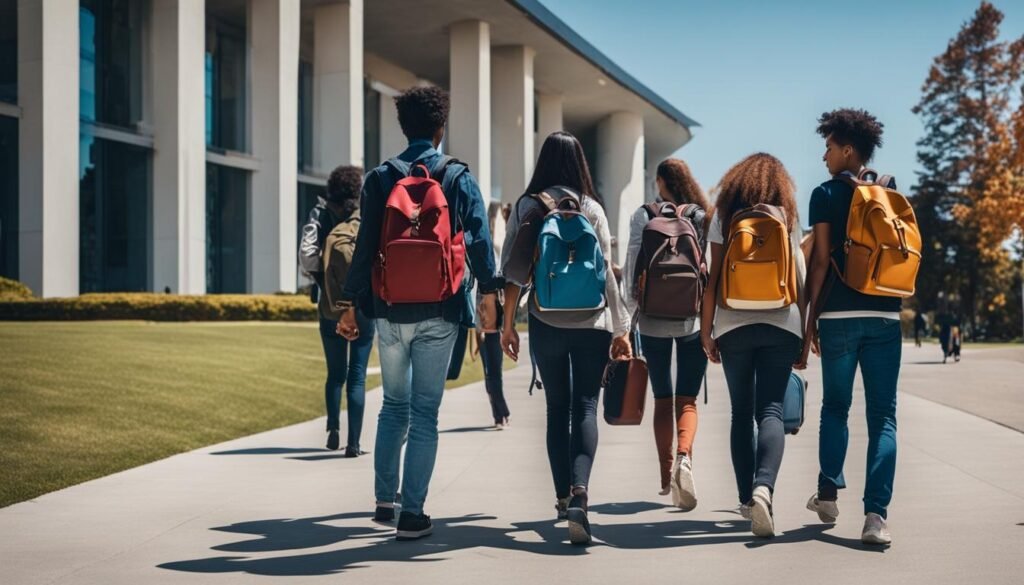Taking a gap year after high school graduation is becoming increasingly popular among students in the Philippines. It offers an opportunity to focus on personal growth, traveling, and gaining real-world experience before starting college. On the other hand, direct college entry allows students to pursue their degree immediately after high school, without taking a break. Both options have their pros and cons, and it is important for students to carefully consider their goals and priorities before making a decision.
Key Takeaways:
- Deciding between a gap year and direct college entry is a personal choice.
- Gap year allows for personal growth, travel, and real-world experience.
- Direct college entry offers a seamless transition and a shorter time to complete the degree.
- Consider motivations, goals, and financial situation when choosing between the two.
- COVID-19 may impact travel plans for a gap year.
Pros and Cons of Taking a Gap Year
When it comes to deciding between a gap year and direct college entry, there are several factors to consider. Let’s explore the pros and cons of taking a gap year in further detail.
Pros of Taking a Gap Year
There are numerous benefits to taking a gap year before starting college. Firstly, it provides an opportunity to recharge and refocus after the rigors of high school. Taking time off allows students to rest, rejuvenate, and gain a fresh perspective before embarking on their higher education journey.
Moreover, a gap year can offer valuable work experience and important life skills. Whether it’s through internships, part-time jobs, or volunteering, students can gain practical knowledge and develop transferable skills that will be beneficial in their future careers.
Exploring different interests and passions is another advantage of a gap year. This extended break allows individuals to pursue hobbies, travel to new places, and engage in activities they are passionate about. It encourages personal growth and self-discovery.
Lastly, taking a gap year can help students build a strong resume. Many universities and employers value the diverse experiences and maturity that come with a gap year. It can set individuals apart from their peers and enhance their future academic and career prospects.
Cons of Taking a Gap Year
While a gap year has its advantages, there are also potential drawbacks to consider. One of the main concerns is the possibility of wasting time and losing academic momentum. It is important for students to stay motivated and have a well-defined plan for their gap year to avoid falling behind.
The cost of gap year programs or travel is another factor to consider. Depending on the activities and destinations chosen, a gap year can be financially demanding. It is crucial to budget and plan accordingly to ensure that the financial implications are manageable.
Feelings of isolation or falling behind peers can also arise during a gap year. While it can be a rewarding and transformative experience, there may be moments when individuals feel disconnected from their social network or worry about not progressing alongside their friends.
Lastly, a gap year requires careful planning and goal-setting. Without a clear roadmap, it can be easy to lose focus and waste precious time. Setting specific objectives and creating a timeline can help maximize the benefits of a gap year.
In summary, a gap year offers the chance to recharge, gain valuable experience, explore passions, and build a strong resume. However, it is essential to consider the potential for wasting time, financial implications, feelings of isolation, and the need for careful planning. By weighing these pros and cons, students can make an informed decision that aligns with their goals and priorities.
Benefits of Direct College Entry
Direct college entry offers several benefits for students in the Philippines. Firstly, it provides a seamless transition from high school to college, eliminating the need for a gap year or a break in education. This allows students to hit the ground running and dive into their chosen field of study without delay.
A major advantage of direct college entry is the ability to start working towards a degree immediately, enabling students to make progress on their educational journey. By starting college right after high school, students can complete their education in a shorter timeframe, giving them a head start in their careers.
Furthermore, direct college entry allows students to maintain the academic mindset and momentum they developed during high school. By continuing their education without interruption, students can build on their existing knowledge and skills, ensuring a smooth transition from one educational level to the next.
Another significant benefit of direct college entry is the opportunity for students to network and form connections early on. By joining college immediately, students can engage with their peers, professors, and alumni, establishing valuable relationships that can support their academic and professional growth throughout their college years and beyond.

Considerations for Choosing a Gap Year
When it comes to deciding whether to take a gap year, there are several important considerations that students should keep in mind. By taking the time to carefully think through these factors, students can make a well-informed decision that aligns with their goals and aspirations.
First and foremost, it is essential for students to examine their motivations and goals for the gap year. Do they want to explore a particular interest, gain work experience, or simply take a break and recharge? Having a clear understanding of why they want to take a gap year will help students make the most of this time and set meaningful goals for themselves.
Additionally, students must consider how they plan to spend their gap year. Will they be volunteering, working, participating in an organized program, or traveling? Having a concrete plan in place will ensure that the gap year is purposeful and productive. It will also help students communicate their experiences effectively when it comes time to apply for college.

Speaking of college applications, students need to think about how taking a gap year will impact their application process. Some schools may have specific policies or requirements for students who have taken a gap year, so it is crucial to research and understand these guidelines ahead of time. Knowing how the gap year will be perceived by admissions officers can help students prepare a compelling application.
Lastly, students must consider the financial implications of taking a gap year. Will they be able to afford the expenses associated with their chosen activities? It is crucial to have a realistic understanding of the financial commitments and to plan accordingly. Exploring scholarships or funding options specific to gap years can also be beneficial.
In conclusion, choosing to take a gap year is a significant decision that requires careful thought and consideration. By reflecting on their motivations, planning how to spend their time, understanding the impact on college applications, and assessing the financial implications, students can make an informed choice that sets them up for success in their academic journey.
Navigating the Gap Year in 2022
The COVID-19 pandemic has introduced new challenges and considerations for students planning to take a gap year in 2022. As the world continues to grapple with travel restrictions and the uncertainties surrounding the virus, it is crucial for students to be well-informed and prepared for their gap year journey.
The Impact of Travel Restrictions
Travel restrictions imposed by various countries can significantly affect students’ plans to embark on international gap year adventures. It is essential for students to stay updated on the latest travel advisories and regulations in their desired gap year destinations. This includes being aware of quarantine requirements, vaccination passports, and any other restrictions that may be in place due to the ongoing pandemic.

Adapting to Disruptions and Delays
Students must also be prepared for the potential disruption or delay of their travel plans. COVID-19 outbreaks and changing restrictions can result in sudden cancellations or changes in itinerary. Having a backup plan is essential to ensure that students can adapt to unforeseen circumstances and make the most of their gap year experience.
Exploring Alternatives
While international travel may be challenging, students can still have a productive and rewarding gap year within their own country. There are numerous opportunities for working, volunteering, or taking online courses that can provide valuable experiences and personal growth. Students can explore local initiatives, community projects, or virtual internships to make the most of their gap year.

Although travel restrictions and the ongoing COVID-19 pandemic have undoubtedly presented obstacles, it is important to remember that a gap year can still be a transformative and enriching experience. By staying informed, flexible, and open to new opportunities, students can navigate the challenges and make the most of their gap year in 2022.
Conclusion
The decision to choose between a gap year and direct college entry is a crucial one, shaped by individual circumstances and aspirations. It is essential for students in the Philippines to carefully evaluate their motivations, goals, and financial situation before making this important choice. Both options have their own sets of advantages and disadvantages, and understanding these is key to making an informed decision.
In light of the current circumstances, it is also important to consider the impact of the COVID-19 pandemic and any travel restrictions that may be in place. Students should have a contingency plan in case travel is not feasible or advisable. However, there are still plenty of opportunities for a productive and enriching gap year experience within the country, such as working, volunteering, or taking online courses.
Ultimately, what matters most is selecting the path that aligns with one’s aspirations and will set them up for success in future academic and professional endeavors. By assessing their personal circumstances, setting clear goals, and considering the current situation, students can confidently make a gap year decision or opt for direct college entry that suits their individual needs.
Source Links
- https://post.edu/blog/pros-and-cons-of-a-gap-year/
- https://www.bestcolleges.com/blog/what-is-a-gap-year/
- https://bridge-u.com/resources/gap-year-post-pandemic/


